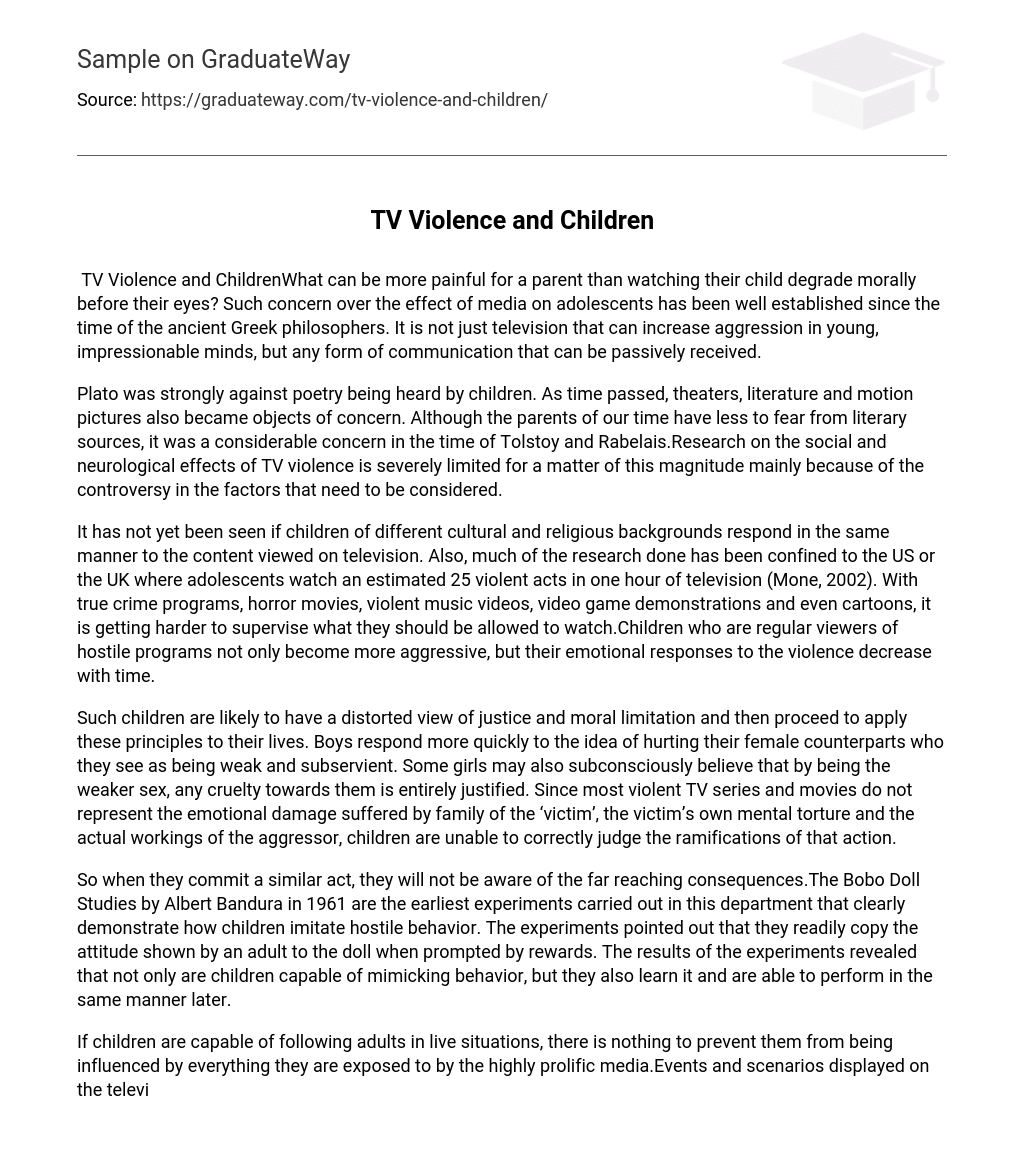TV Violence and ChildrenWhat can be more painful for a parent than watching their child degrade morally before their eyes? Such concern over the effect of media on adolescents has been well established since the time of the ancient Greek philosophers. It is not just television that can increase aggression in young, impressionable minds, but any form of communication that can be passively received.
Plato was strongly against poetry being heard by children. As time passed, theaters, literature and motion pictures also became objects of concern. Although the parents of our time have less to fear from literary sources, it was a considerable concern in the time of Tolstoy and Rabelais.Research on the social and neurological effects of TV violence is severely limited for a matter of this magnitude mainly because of the controversy in the factors that need to be considered.
It has not yet been seen if children of different cultural and religious backgrounds respond in the same manner to the content viewed on television. Also, much of the research done has been confined to the US or the UK where adolescents watch an estimated 25 violent acts in one hour of television (Mone, 2002). With true crime programs, horror movies, violent music videos, video game demonstrations and even cartoons, it is getting harder to supervise what they should be allowed to watch.Children who are regular viewers of hostile programs not only become more aggressive, but their emotional responses to the violence decrease with time.
Such children are likely to have a distorted view of justice and moral limitation and then proceed to apply these principles to their lives. Boys respond more quickly to the idea of hurting their female counterparts who they see as being weak and subservient. Some girls may also subconsciously believe that by being the weaker sex, any cruelty towards them is entirely justified. Since most violent TV series and movies do not represent the emotional damage suffered by family of the ‘victim’, the victim’s own mental torture and the actual workings of the aggressor, children are unable to correctly judge the ramifications of that action.
So when they commit a similar act, they will not be aware of the far reaching consequences.The Bobo Doll Studies by Albert Bandura in 1961 are the earliest experiments carried out in this department that clearly demonstrate how children imitate hostile behavior. The experiments pointed out that they readily copy the attitude shown by an adult to the doll when prompted by rewards. The results of the experiments revealed that not only are children capable of mimicking behavior, but they also learn it and are able to perform in the same manner later.
If children are capable of following adults in live situations, there is nothing to prevent them from being influenced by everything they are exposed to by the highly prolific media.Events and scenarios displayed on the television have another effect of removing the limitations and inhibitions created by parental figures. While they dissuade against aggression and negative domination, repeated viewing of the same situations on TV convince the children that such acts are natural and preferable than more passive methods like discussion. Even characters like superheroes cultivate the belief that there is hardly any problem that cannot be solved without physical assertion of personal will.
Reactions of the television watchers will vary according to the environment in which they are watching it. A group of children will behave differently to a violent event if there is a dominant personality in the group who is capable of either instigating the rest of them into idealizing the event they are watching or convincing them that what they are seeing is wrong. If the child is accompanying adults, he is most often a passive watcher and not in control of the content and will again be under the influence of the TV and the comments of the people around him. In the same way, children respond differently to fictitious programs as compared to real events shown in news casts.
The latter will be watched with a different mindset and those who have not been completely desensitized will appreciate the reality of the content.TV Violence is not simply limited to the cut and dried definition of physical hostility, but includes borderline aspects like psychological torture, racial and religious discrimination and reality deformation. Highly impressionable children that are not often supervised have greater chances of growing up to be extremely aggressive, less tolerant of ideological differences and less sensitive to human suffering than those who spend less time watching TV and who have well established morals. Furthermore, while it impossible to completely control what children are watching, it is possible to supervise them whenever possible and instill in them the importance of critical viewing.
Once this sensitive age group is perceptive of the harms of what media brings them and what is beneficial for them, they are less likely to become victims of it. Bibliography Bandura, A., Ross D., Ross S.
A. Transmission of Aggression through Imitation of Aggressive Models (1961) Retrieved October 23, 2008 from Classics in the History of Psychology at http://psychclassics.yorku.ca/Bandura/bobo.
htmChandler, D. Television Violence and Children’s Behavior (1992) Retrieved October 23, 2008 from http://www.aber.ac.uk/media/Modules/TF33120/tv-violence_and_kids.html





